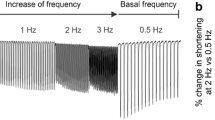Abstract
This study was undertaken to investigate the effects of oxygen free radicals on myofibrillar creatine kinase activity. Isolated rat heart myofibrils were incubated with xanthine+xanthine oxidase (a superoxide anion radical-generating system) or hydrogen peroxide and assayed for creatine kinase activity. To clarify the involvement of changes in sulfhydryl groups in causing alterations in myofibrillar creatine kinase activity, 1) effects of N-ethylmaleimide (sulfhydryl groups reagent) on myofibrillar creatine kinase activity, 2) effect of oxygen free radicals on myofibrillar sulfhydryl groups content, and 3) protective effects of dithiothreitol (sulfhydryl groups-reducing agent) on the changes in myofibrillar creatine kinase activity due to oxygen free radicals were also studied. Xanthine+xanthine oxidase inhibited creatine kinase activity both in a time-and a concentration-dependent manner. Superoxide dismutase (SOD) showed a protective effect on the depression in creatine kinase activity caused by xanthine+xanthine oxidase. Hydrogen peroxide inhibited creatine kinase activity in a concentration-dependent manner; this inhibition was prevented by the addition of catalase. N-ethylmaleimide reduced creatine kinase activity in a dose-dependent manner. The content of myofibrillar sulfhydryl groups was decreased by xanthine+xanthine oxidase; this reduction was protected by SOD. Furthermore, the depression in myofibrillar creatine kinase activity by xanthine+xanthine oxidase was protected by the addition of dithiothreitol. Oxygen free radicals may inhibit myofibrillar creatine kinase activity by modifying sulfhydryl groups in the enzyme protein. The reduction of myofibrillar creatine kinase activity may lead to a disturbance of energy utilization in the heart and may contribute to cardiac dysfunction due to oxygen free radicals.
Similar content being viewed by others
References
Feeman BA, Crapo JD: Biology of disease: Free radicals and tissue injury. Lab Invest 47: 412–426, 1982
Halliwell B, Grootreld M: The measurement of free radicals in humans. FEBS Lett 213: 9–14, 1986
Gupta M, Singal PK: Oxygen radical injury in the presence of desferal, a specific iron-chelating agent. Biochem Pharmacol 36: 3774–3777, 1987
Przyklenk K, Whittaker P, Kloner RA: Direct evidence that oxygen free radicals cause contractile dysfunctionin vivo. Circulation 78 (Suppl II): II-264, 1988
Saks VA, Ventura-Clapier R, Huchua ZA, Preobrazhensky AN, Emelin IV: Creatine kinase in regulation of heart function and metabolism. I. Further evidence for compartmentation of adenine nucleotides in cardiac myofibrillar and sarcolemmal coupled ATPase-creatine kinase systems. Biochem Biophys Acta 803: 254–264, 1984
Wallimann T, Schlosser T, Eppenberger HM: Function of M-line-bound creatine kinase in myofibrillar ATP regenerator at the receiving end of the phosphorylcreatine shuttle in muscle. J Biol Chem 259: 5238–5246, 1984
Bessman SP, Yang WCT, Geiger PJ, Erickson-Viitanen S: Intimate coupling of creatine phosphokinase and myofibrillar adenosine triphosphatase. Biochem Biophys Res Commun 96: 1414–1420, 1980
Yagi K, Mase R: Coupled reaction of creatine kinase and myosin A-adenosine triphosphatase. J Biol Chem 259: 5238–5246, 1984
Fossel ET, Hoefeler H: Complete inhibition of creatine kinase in isolated perfused rat hearts. Am J Physiol 252 (Endocrinol Metab 15): E124–E130, 1987
Kaneko M, Beamish RE, Dhalla NS: Depression of heart sarcolemmal Ca2+-pump activity by oxygen free radicals. Am J Physiol 256 (Heart Circ Physiol 25): H368–H374, 1989
Kaneko M, Elimban V, Dhalla NS: Mechanism for depression of heart sarcolemmal Ca2+-pump by oxygen free radicals. Am J Physiol 257 (Heart Circ Physiol 26): H804–H811, 1989
Kaneko M, Lee SL, Wolf CM, Dhalla NS: Reduction of calcium channel antagonist binding sites by oxygen free radicals in rat heart. J Mol Cell Cardiol 21: 935–943, 1989
Kaneko M, Chapman DC, Ganguly PK, Beamish RE, Dhalla NS: Modification of cardiac adrenergic receptors by oxygen free radicals. Am J Physiol 260 (Heart Cric Physiol 29): H821–H826, 1991
Okabe E, Hess ML, Oyama M, Ito H: Characterization of free radical-mediated damage of canine cardiac sarcoplasmic reticulum. Arch Biochem Biophys 225: 164–177, 1983
Otani H, Tanaka H, Inoue T, Umemoto M, Omoto K, Tanaka K, Sato T, Osako T, Masuda A, Nonoyama A, Kagawa T.In vivo study on contribution of oxidative metabolism of isolated rabbit heart mitochondria to myocardial reperfusion injury. Circ Res 55: 168–175, 1984
Solaro RJ, Pang DC, Briggs FN: The purification of cardiac myofibrils with Triton X-100. Biochem Biophys Acta 245: 259–262, 1971
Lowry OH, Rosebrough NJ, Farr AL, Randall RJ: Protein measurement with Folin phenol reagent. J Biol Chem 193: 265–275, 1951
Hess JW, MacDonald RP, Natho GJW, Murdock KJ: Serum creatine phosphokinase: Evaluation of a commercial spectrophotometric method. Clin Chem 13: 994–1005, 1967
Schoot BM, Schoots AFM, Depont JJHHM, Schuurmans-Stekhoven FMAH, Bonting SL: Studies on (Na++K+) activated ATPase. XLI: Effects of N-ethylmaleimide on overall and partial reactions. Biochim Biophys Acta 483: 181–192, 1977
Yamada S, Ikemoto N: Distinction of thiols involved in the specific reaction steps of the Ca2+-ATPase of the sarcoplasmic reticulum. J Biol Chem 253: 6801–6807, 1987
Trundle D, Cunningham LW: Iodine oxidation of the sulfhydryl groups of creatine kinase. Biochemistry 8: 1919–1925, 1969
Bolli R, Jeroudi MO, Patel BS, DuBose CM, Lai EK, Robert R, McCay PB: Direct evidence that oxygen-drived free radicals contribute to postischemic myocardial dysfunction in intact dog. Proc Natl Acad Sci USA 86: 4695–4699, 1989
Zweier JL, Flaherty JT, Weisfedt ML: Direct measurement of free radical generation following reperfusion of ischemic myocardium. Proc Natl Acad Sci USA 84: 1404–1407, 1987
Greenfield RA, Swain JL: Disruption of myofibrillar energy use: Dual mechanism that may contribute to postischemic dysfunction in stunned myocardium. Circ Res 60: 283–289, 1987
Vial C, Font B, Goldschmidt P, Gantheron DC: Dissociation and reassociation of creatine kinase with heart mitochondria: pH and phosphate dependence. Biochem Res Commun 88: 1352–1359, 1979
Bittle JA, Weisfeldt ML, Jacobus WE: Creatine kinase of heart mitochondria: Progressive loss of energy activity duringin vivo ischemia and its correlation to depressed myocardial function. J Biol Chem 260: 208–214, 1985
Suzuki S, Kaneko M, Chapman DC, Dhalla NS: Alterations in cardiac contractile proteins due to oxygen free radicals. Biochem Biophys Acta 1074: 95–100, 1991
Author information
Authors and Affiliations
Rights and permissions
About this article
Cite this article
Kaneko, M., Masuda, H., Suzuki, H. et al. Modification of contractile proteins by oxygen free radicals in rat heart. Mol Cell Biochem 125, 163–169 (1993). https://doi.org/10.1007/BF00936445
Received:
Accepted:
Issue Date:
DOI: https://doi.org/10.1007/BF00936445




